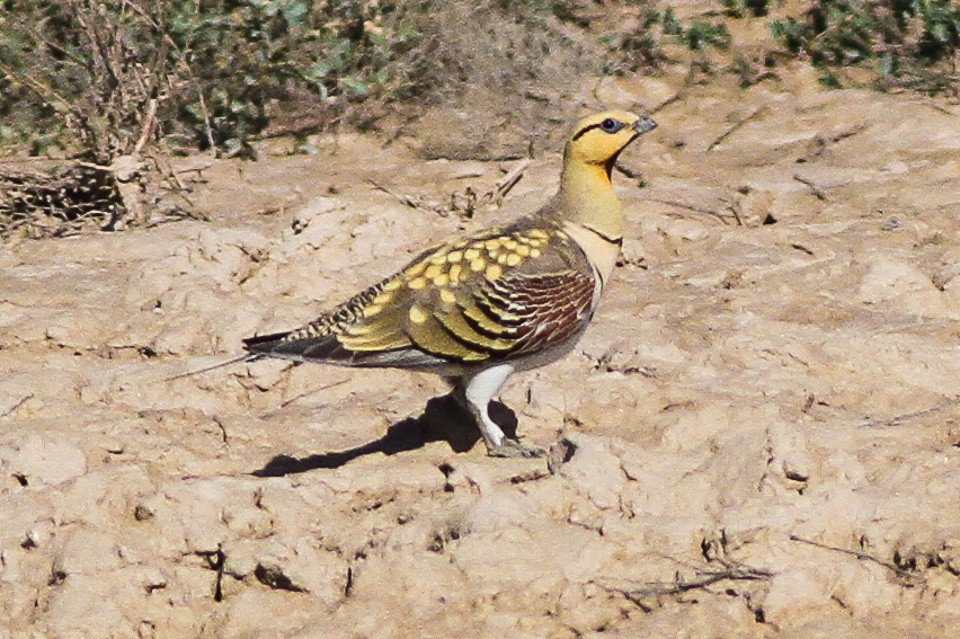Pin-tailed Sandgrouse
A species of Sandgrouse Scientific name : Pterocles alchata Genus : Sandgrouse
Pin-tailed Sandgrouse, A species of Sandgrouse
Botanical name: Pterocles alchata
Genus: Sandgrouse
Content
Description General Info
Description
The pin-tailed sandgrouse is a robust, medium-sized bird about 31 to 39 centimetres (12 to 15 in) in length. The general colouring is cryptic, a blend of barred and flecked olive green, brown, buff, yellow, grey and black. The underparts and the feathered legs are dull white. The sexes are different and the male's plumage varies with the time of year. In the breeding season, the male has the crown, most of the neck, the back and under-wing coverts a yellowish-green colour with dull yellow spots in the shoulder region. The cheeks are also yellow with a narrow black line extending from the beak, through the eye to the nape of the neck. The irises are brown and the beak is slatey grey. There is a black patch on the throat immediately below the beak and below this, there is a broad, reddish-brown band round the breast, bordered by a thin black stripe above and below the band. The outer wing coverts are chestnut edged with black and white and the primaries are black with pale edges which gives both the leading and trailing edges of the wing the appearance of a black rim in flight. The rump and the tail are distinctly barred in black and brownish-yellow and the streamers on the central tail feathers are slate-grey. Outside the breeding season, all the upper parts, including the crown and cheeks, are barred in black and brownish-yellow and the throat loses its black patch, becoming whitish. The female is generally similar to the male but the colours are duller. The cheeks and neck are golden-buff and lack the greenish tinge of the male. There is a black stripe running through the eye. The chin is white and there is an additional yellow-buff band across the breast with a broad black stripe above, another thinner one about a third of the way down and a further narrow black stripe at the base. The back and wings are grey, barred with black. The rump and the tail (which has shorter central feathers than the male) are similar in colouration to the male but have finer black barrings. In flight, the pin-tailed sandgrouse can be identified by its bright, white underparts and under-wing coverts, and the long feathers in the centre part of its tail. It is usually silent when on the ground but in the air communicates with other birds with a frequently uttered, loud "kattar-kattar", a nasal "ga-ga-ga" and a low-pitched "gang gang". 
Size
39 cm
Nest Placement
Ground
Feeding Habits
Pin-tailed Sandgrouse primarily consume seeds, particularly legumes, and also ingest green plants and cereals. Incidental intake of invertebrates occurs, often ingesting grit for digestion. Pin-tailed Sandgrouse forage mainly in the morning and occasionally before sunset, forming large flocks in non-breeding season and feeding alone or in pairs during breeding season.
Habitat
Pin-tailed Sandgrouse thrive in semi-arid to arid environments, predominantly occupying open areas such as semi-deserts, steppes, and dry mudflats near marshes, as well as agricultural lands with minimal vegetation. Adapted to flat terrains with clayey or sandy soils, they prefer locations benefiting from moderate winter–spring rainfall. Nesting areas are typically found in pastures, fallows, and less cultivated wastelands, avoiding dense vegetation and hilly landscapes.
Dite type
Granivorous
General Info
Feeding Habits
Bird food type
Behavior
The pin-tailed sandgrouse often feeds in groups and gathers regularly in large numbers at waterholes, to which the birds fly soon after dawn. During the day they disperse to forage for seeds, which are the main part of their diet, and also eat buds, green shoots and leaves. They favour leguminous seeds and also eat seeds of knotweed (Polygonum), buckwheat (Fagopyrum), Salicornia, Artemisia, camelthorn (Alhagi), rock rose (Helianthemum) and asphodel (Asphodelus). In cultivated areas they take grain and the seeds of leguminous crops. Beetles and other small invertebrates are sometimes eaten and grit is consumed to help grind up the contents of the crop. 
Distribution Area
The pin-tailed sandgrouse breeds in North Africa and the Middle East, Turkey, Iran, Iraq and Kazakhstan. In Europe it breeds in Spain, Portugal and the southern part of France. Eastern populations, particularly those from Kazakhstan, migrate to Pakistan and parts of northern India in winter. The pin-tailed sandgrouse inhabits open areas of stony land, semi arid areas at the edge of deserts, treeless plains and occasionally dried-out mud flats. In winter it may visit ploughed or fallow land but prefers sandy soils and is much less reliant on vegetation cover than the black-bellied sandgrouse (Pterocles orientalis) which has a similar range. It does not occur at elevations above about 1,000 metres (3,300 ft). 
Species Status
The pin-tailed sandgrouse is rated as being of "Least Concern" by BirdLife International. This is because it has a large range and the population, estimated to be somewhere between 130,000 and 1,500,000 individuals, is believed to be stable. The range may be expanding in south eastern Turkey, possibly as a result of changes in climate. However, the populations in parts of Europe are decreasing due to changes in agricultural production. The bird remains common in Spain but in the only remaining locality in southern France where it is found, at La Crau, only about 170 pairs remained in 2002, while there were fewer than 100 pairs of birds breeding in Portugal in the same year. 
Scientific Classification
Phylum
Chordates Class
Birds Order
Sandgrouse Family
Sandgrouse Genus
Sandgrouse Species
Pin-tailed Sandgrouse 